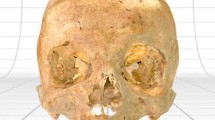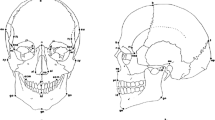Abstract
A mummy of an Egyptian priestess dating from the 22nd dynasty (c. 770 BC), completely enclosed in an anthropoid (human shaped) coffin, was scanned on a CT scanner. An accurate reconstruction of the cranium was generated from 115 × 2 mm CT images using AVS/Express on a SGI computer. Linear measurements were obtained from six orthogonal cranial views and used in a morphometric analysis software package (CRANID). The analyses carried out were both linear and nearest neighbour discriminant analysis. The results show that there is a 52.9% probability that the mummy is an Egyptian female, with a 24.5% probability that the mummy is an African female. Thus the technique confirms that the coffin contains an Egyptian female, which is consistent with the inscription on the coffin and the shape of the pelvic bones as revealed by plain X-rays. These results show that this technique has potential for analysing forensic cases where the bones are obscured by soft tissue and clothing. This technique may have an application in virtual autopsies.
Similar content being viewed by others
References
Dawson, W.R and Gray, P.H.K.,Catalogue of Egyptian antiquities in the British Museum: 1 mummies and human remains, British Museum Press, London, 8, 1968.
Hughes, S.W., Sofat, A., Baldock, C.,CT imaging of an Egyptian Mummy, British Journal of Non-Destructive Testing, 35:369–374, 1993.
Hughes, S.W.,3D reconstruction of an ancient Egyptian Mummy, British Museum, Occasional paper, No.114:211-225, 1996.
Baldock, C., Hughes, S.W., Whittaker, D.K., Taylor, J., Davis, R., Spencer, A.J., Tonge, K.,3-D Reconstruction of an ancient Egyptian mummy using X-ray computer tomography, J. R. Soc. Med., 87:806–808, 1994
Wright, R.V.S.,Correlation between cranial form and geography in Homo sapiens: CRANID-a computer program for forensic and other applications, Archaeology in Oceania, 27:105–112, 1992.
Howells, W.W.,Cranial Variation in Man: a Study by Multivariate Analysis of Patterns of Difference Among Recent Human Populations, Papers of the Peabody Museum, Harvard University, Vol.67, 1973.
Howells, W.W.,Skull Shapes and the Map: Craniometric Analyses in the Dispersion of Modern Homo. Papers of the Peabody Museum, Harvard University, Vol.79, 1989.
Krzanowski, W.J. and Marriott, F.H.C.,Multivariate Analysis Part 2: Classification, Covariance Structures and Repeated Measurements, Arnold, London, 1995.
Devijver, P.A., Kittler, J.,Pattern Recognition: a Statistical Approach. Prentice/Hall International, Englewood Cliffs, New Jersey, 1982.
Author information
Authors and Affiliations
Corresponding author
Rights and permissions
About this article
Cite this article
Hughes, S., Wright, R. & Barry, M. Virtual reconstruction and morphological analysis of the cranium of an ancient Egyptian mummy. Australas. Phys. Eng. Sci. Med. 28, 122–127 (2005). https://doi.org/10.1007/BF03178703
Received:
Accepted:
Issue Date:
DOI: https://doi.org/10.1007/BF03178703




